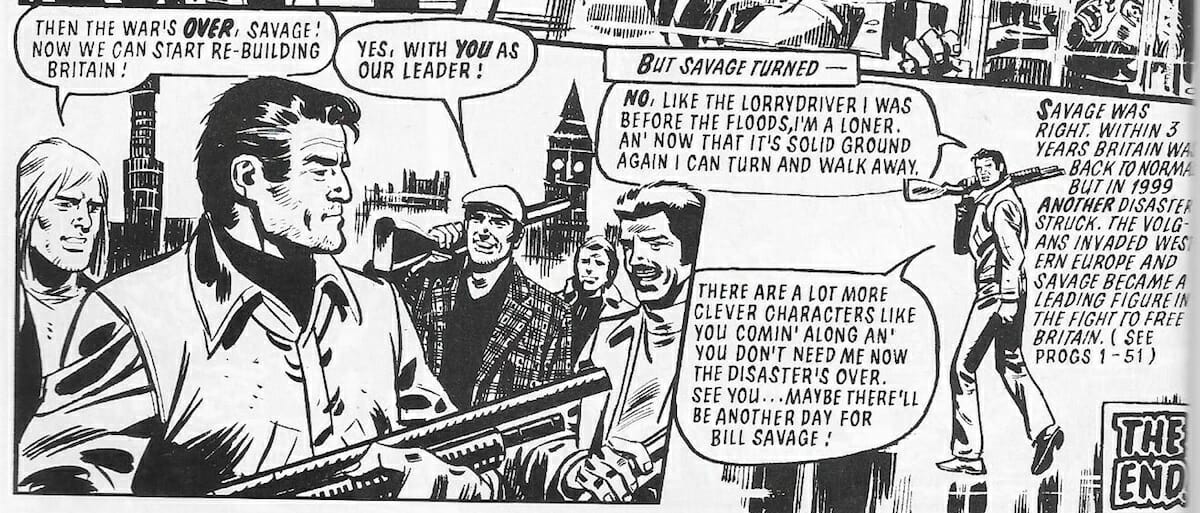In the olden days, IPC had distinct publishing departments for boys, girls, humour, and nursery comics. Boys’ comics had become a very staid, conservative world in comparison to what kids could see on the telly, but girls’ comics were being shaken up by Tammy and Jinty. Long-time 2000 AD editor Steve MacManus wrote in his autobiography, The Mighty One, that Tammy starred “downtrodden yet gutsy protagonists… put through darker, nastier trials” than their rivals; and Pat Mills, who wrote a number of these strips, told Memorabilia Magazine the audience enjoyed “hard, gutsy stories that don’t have to have a happy ending” but did have a “cruel edge”. The boys’ comic renaissance would be spearheaded by girls’ comic veterans like Mills and Disaster 1990!’s writer Gerry Finley-Day, and would similarly have downtrodden, gutsy working-class heroes facing nasty trials in cruel-edged stories.
In 1976, British girls anthology comic Jinty ran Alan Davidson and Phil Gascoine’s Fran of the Floods, a story where Britain’s cities have been swept away by the rising tide, civilisation has ended, and our hero, Fran, has to survive a savage new world. In 1979, 2000 AD ran Gerry Finley-Day and Carlos Pino’s Disaster 1990! (with assists by Mike White and Alan Willow), a story where – funnily enough – Britain’s cities have been swept away by the rising tide, civilization has ended, and our hero, Bill, has to survive a savage new world of chaos.
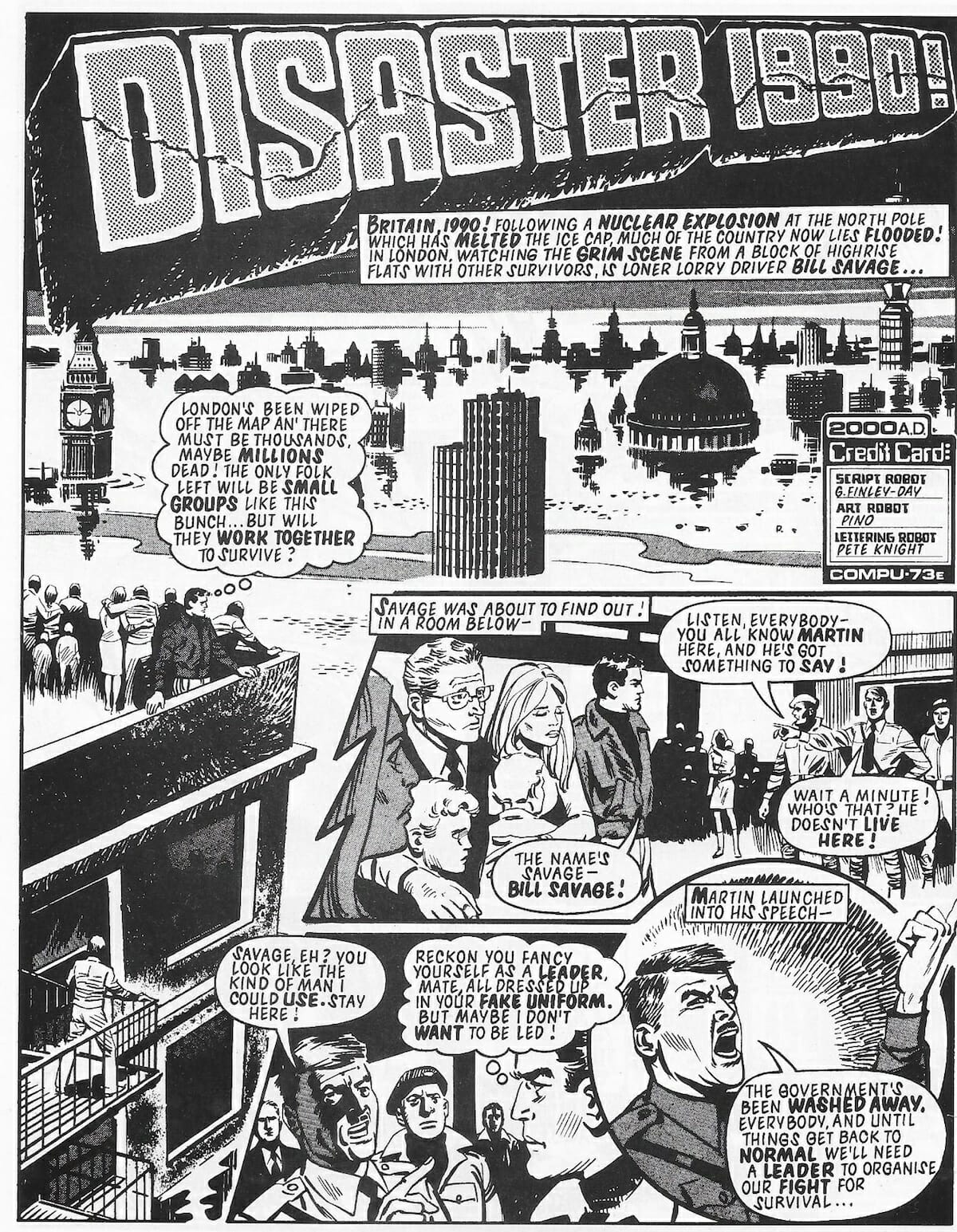
If those similarities weren’t enough for you somehow, both series also featured their lead characters crossing the country, both end with the floods just happening to stop, and both show fascism rising to take over. But Jinty was a comic aimed for young girls while 2000 AD was a comic aimed for young boys – and in a way that feels oddly gendered in hindsight, this does mean we can compare the two strips to see how 1970s British comics treated their audiences and what they thought they wanted.
And so here we are: two strips with the same premise, representing the dominant models of IPC’s renaissance period. I’ll note that while Fran of the Floods is quite good, Disaster 1990! was seen as “not quite working out” even in ’79. This actually helps the comparison as it means Disaster 1990! is very bluntly showing us the boys’ comic formula. Even the strip names point to differences – Jinty says ‘this is about a normal girl who finds strength in a strange and horrifying situation’ and 2000 AD screams ‘BAD SHIT HAPPENS IN THE FUTURE!’.
Fran’s apocalypse is a growing natural disaster that builds and builds and you cannot stop, it’s coming to sweep away your world. (“Refugees come from faraway places! You don’t get refugees from East Anglia!”) After all, as the book opens Fran Scott is a normal girl who enjoys the rain and is at odds with her sister, while the adults around her hide how bad things are getting. When she realises the end is coming, she stoically swallows her fear to keep others calm during an abortive evacuation. There’s escalating chaos as Britain crumbles and the rain-sodden streets are clogged with people and the lights go out. Finally, floods wash Fran’s home away and leave her stranded in the wilderness. This is, undoubtedly, a survival horror tale.
Meanwhile, when we meet Bill Savage – a returning hero from the strip Invasion! – some bikers are harassing him so he whallops them with a table. There’s news of a disaster because a nuclear-powered boat crashed into a nuclear submarine at the Arctic and caused a “NUCLEAR EXPLOSION!”? Bill’s going to drive towards it! The water strikes on page 4, causing an unlucky bystander to go “AAH!”, and while not as impactful as Fran watching everything crumble, that’s not the point. The point is to get to set up the premise fast so we can have the action. Boys aren’t believed to care how Britain gets flooded – they just want to see Carlos Pino drawing lurid scenes of familiar sites underwater and whirlpools shredding Wembley Stadium. He’s showing his action hero credentials to show he’ll handle the apocalypse, and at the end of the day – don’t you wish you could be Bill Savage, lad?
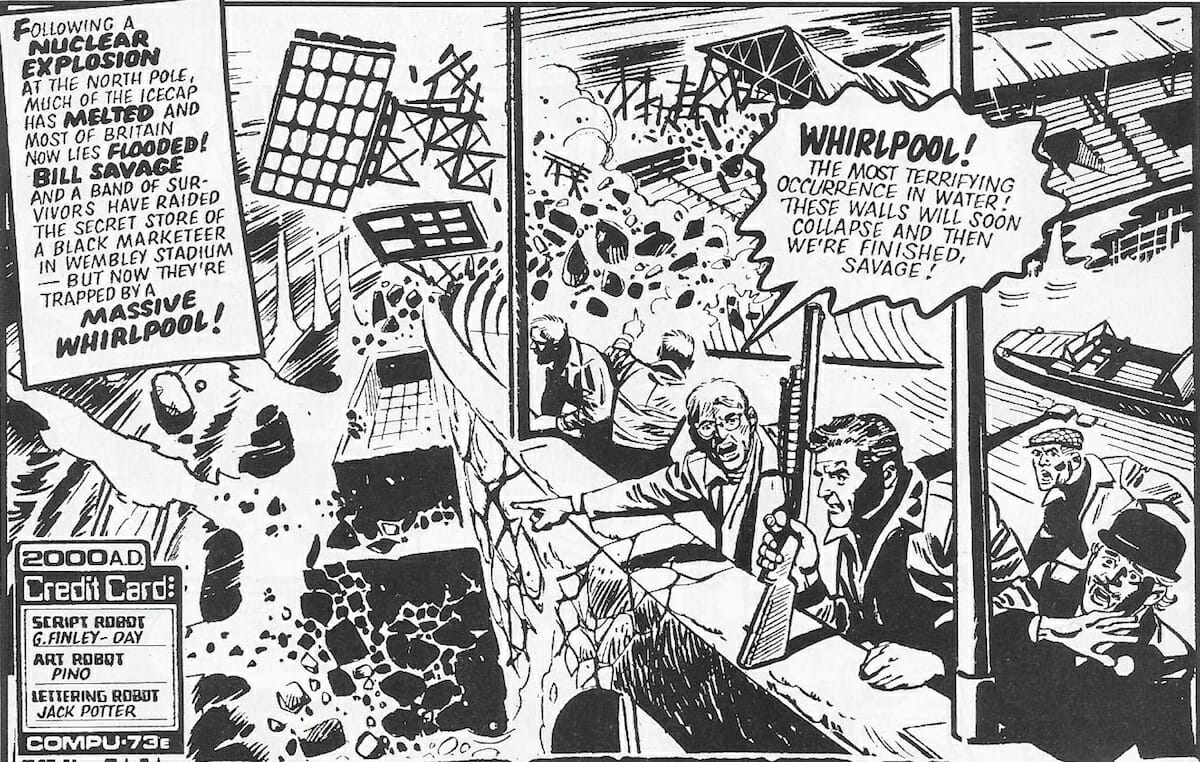
When the floods hit her school, Fran fights for her life, watches her friend Jill be washed away, needs someone to save her (who then dies!), and ends the part lamenting she’s “alone… the last person left alive” in a hostile world. When the floods hit London, however, Savage heroically grabs a small girl out of harm’s way and isn’t seen for a while. While others are horrified by the disaster, his immediate thought is that this is “THE BEGINNING OF THE FIGHT FOR SURVIVAL!” Savage looks out at a vista of exotic destruction while Fran ends a small figure in endless water.
Savage isn’t wrong about that fight, I suppose. After all, he’s dealing with fascist goons and psychotic criminals from the first page of the second installment! Our hero battles new baddies every week or two, from local Hitler cosplayer Martin to a mad scientist who controls swans. The collapse of law and order is something that calls for heroic action against snarling baddies, and artist Carlos Pino does draw some very ugly, sneering villains that cry out to be punched. The strength of each installment rests on how interesting the villain is and how entertaining is the way Savage takes them out. (The mad scientist is pecked to death by his own birds!)
While the fascistic gang of thugs known as The Black Circle eventually emerge in Fran of the Floods, the first threat from law and order collapsing is that in Part 4, her neighbours are kicking her door in to loot the house for food. Their leader is “nice Mr. Jacobs” who is “nice no more” – a message that undeniably cries out that if this happened, that could be your neighbours, kids! The final antagonist is a teenager calling himself the King of Glasgow, revealed to just be a traumatised young man wearing a stage costume, and even then Fran defeats him by her willingness to put herself in harm’s way, rather than thumping.
In each respective story , boys and girls are expected to imagine being the hero, but not in the same way. Throughout her story, Fran is a victim of circumstances; and while brave, her actions are often an act of sacrifice or a display of empathy – saving a village from a plague through an act of kindness that accidentally reveals a cure.
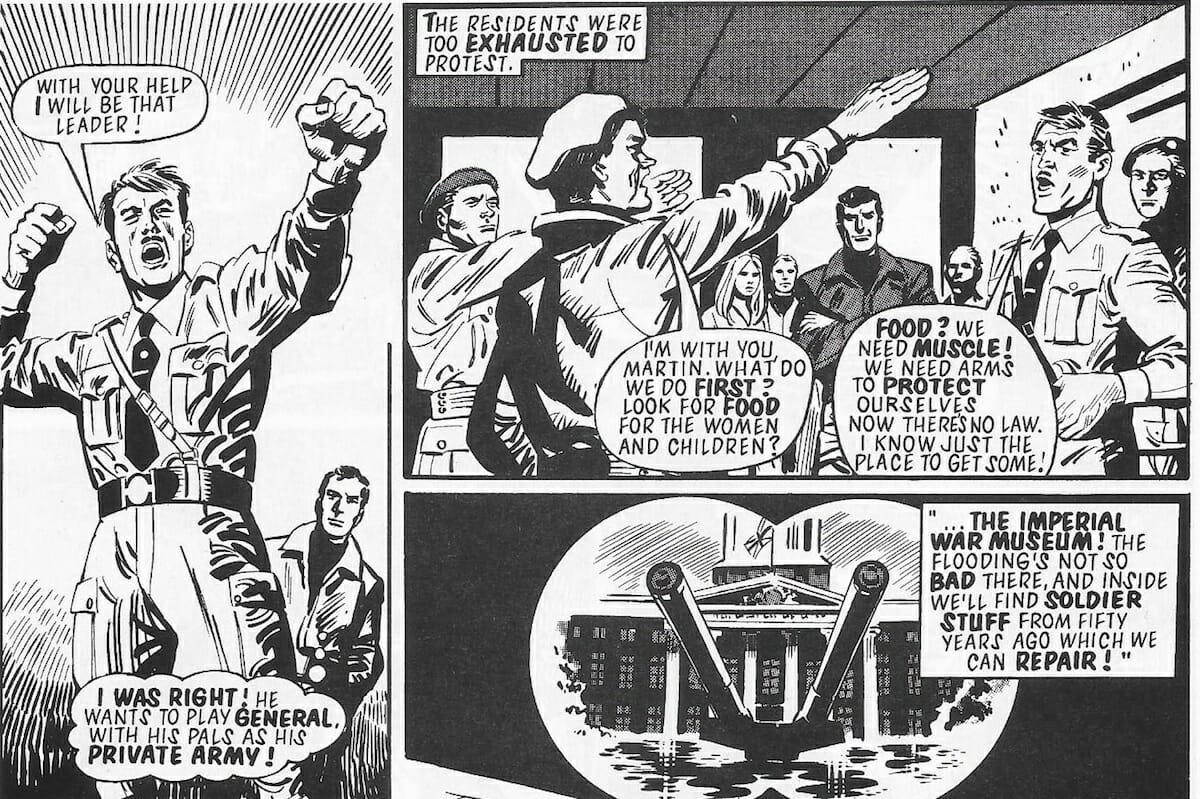
This difference also shows in the ending. Disaster 1990! says in the last page that the floods are over now because the North Pole “got better”. How will Britain recover? Doesn’t matter! Savage drives the plot and boys don’t want to read Planning Permission 1990!, so in a featureless final panel he says he’s leaving and a caption remarks “within 3 years Britain was back to normal”. Fran is the girl who could be you and so isn’t part of the reconstruction, and that means the aftermath is still a crisis to be navigated. Normality is not restored until she’s back with her family in the old house.
As for the supporting cast, in Disaster 1990! the wasteland is populated by thugs that only Savage can stop or victims that need Savage to save them. The surviving Oxford are stuffy posh fools who need Savage’s working-class street smarts. In Part 19, Savage leads a slave uprising, but they’re beaten and all die unnamed at the start of Part 20. Savage was worried about his ol’ mum drowning in Part 1 but she never comes up again once the floods hit; he has no friends who seem to have drowned, and the death of his sidekick Dr Bamber doesn’t rate a mention next week. The supporting cast exist for him to fight or fight for.
By contrast, the first quarter of Fran of the Floods is set in one town, introducing us to people who are important in Fran’s life and who will be abruptly removed from it. Her bitter arguments with her sister are juxtaposed with the floods ripping through Britain. We see teachers and parents and friends, we meet the traitor Mr Jacobs, and we meet surly Rod next door and the school bully Rosie – Rod will come to Fran’s aid against the mob, and Rosie will die saving Fran’s life. The supporting cast feel like they exist when Fran’s not there.
At the end of the day, that’s maybe the biggest difference. Boys get to take forceful action and girls do not, but the girls get to have an emotional life and the boys not so much. There aren’t any fights in Fran’s world. The angry mobs and the King of Glasgow get talked down, while the Black Circle beat up a farmer in a single panel. If you read both stories back-to-back, Fran and everyone she meets can feel like someone Savage would save from bad guys and never learn the names of. While Fran of the Floods is the better story, its weakest point is how the Black Circle are defeated because a flood surge just happens to wash them away rather than anything a character actively does.
This is one of the big weaknesses of gender-segregated comics – or rather, traditional assumptions of what boys and girls wanted. Girls got to fantasize about being brave in the face of adversity but never in the same way boys got to. Obviously tens of thousands of girls did like this, but Mel Gibson’s (not that one) book Remembered Reading quotes women who read boys’ comics or American superhero comics because they weren’t ‘soppy’, because they felt the women in them could save themselves, or simply they got to be violent.
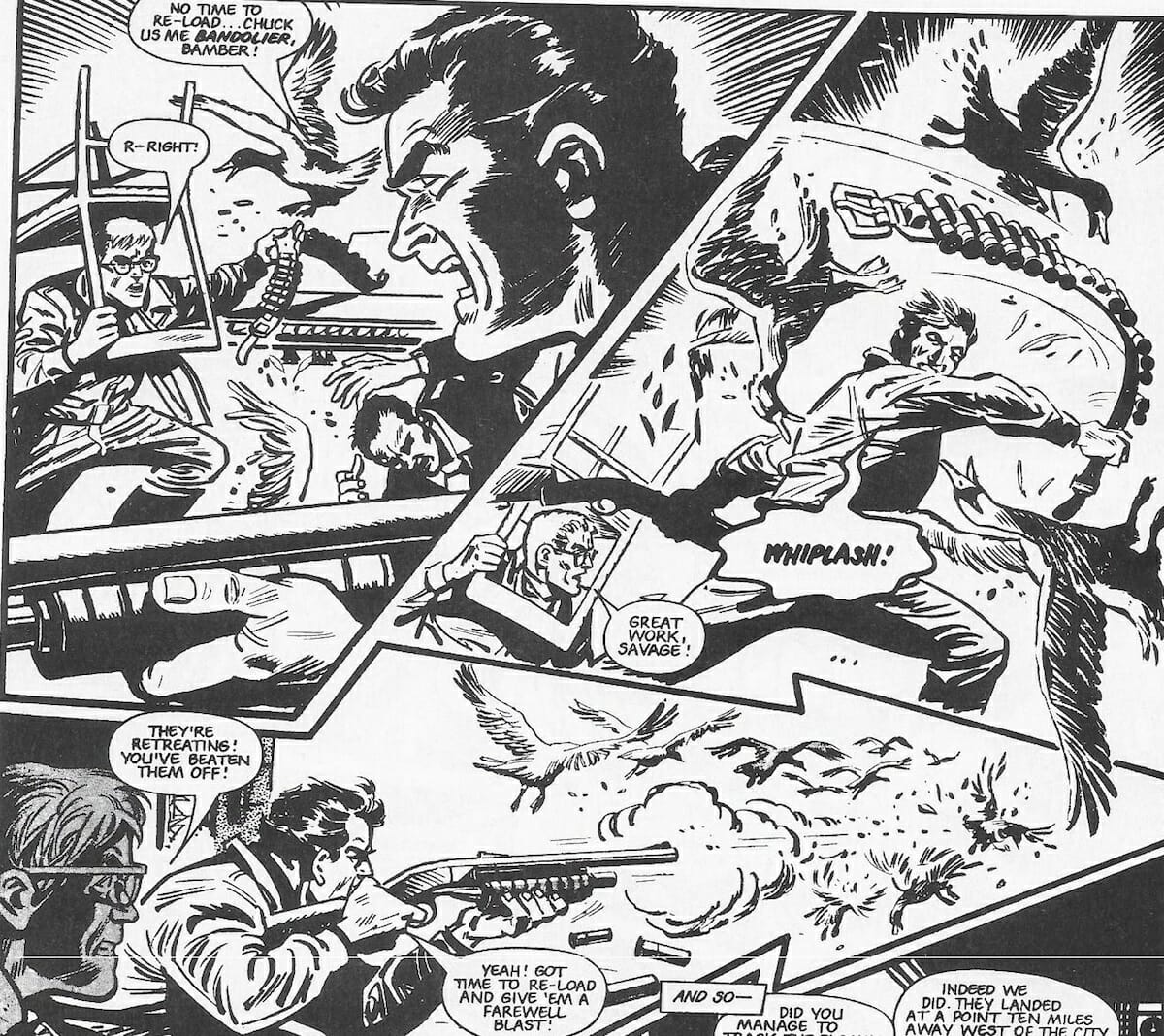
But for all his action, imagine how lonely it must be to be Bill Savage. A man of no past and no future, no real friends or family, wandering out of the room when the others talk about the future and disappearing into a featureless void until there’s another day when you need him to punch someone.
A few years later, Alan Moore would write Skizz and Halo Jones at 2000 AD. Both have female leads, with all the emotional life and kitchen-sink drama of girls’ comics (albeit a space kitchen for Jones), while still having the government chases and future warfare that was confined to boys’ comics. Over time there’d be more strips that borrow from both traditions, bringing us to today’s 2000 AD who encourages kids of all genders to thrill over the same Regened progs.
An often ignored fact of the past, as Gibson records, is that many girls read boys’ comics and also, many boys read girls’ comics to get something different too. How do we think Moore and others knew what tricks to use? Thousands of kids of all genders likely read both Fran of the Floods and Disaster 1990! at the time, scratching different itches: some days, you want an emotional punch to the gut. Another day, you want to see someone get punched in the gut. But as the comic industry rebuilds from the metaphorical floods that swept so much of it away in the late 20th century, we can have hope that maybe – just maybe – the industry has learned everyone can save the day the same way. There’s no need to change the title anymore.
